Analysis of Work Based Learning in Malaysian Polytechnics Report
VerifiedAdded on 2020/04/13
|19
|4263
|116
Report
AI Summary
This report delves into the realm of work-based learning (WBL) within the polytechnic sector, exploring its various models, strengths, and weaknesses. The study investigates the implementation of WBL, particularly in advanced diploma courses, highlighting its role in bridging the gap between institutional and industrial learning. It examines the challenges associated with WBL, such as resource provision, program implementation, and student learning outcomes, while also emphasizing the importance of effective mentorship and instructor training. The report analyzes the association between career development learning, workplace simulations, service learning, and internships with graduate employability. The purpose is to identify improvements and recommendations to enhance the efficiency of WBL, focusing on the roles of instructors, the importance of student readiness, and the integration of theory with practical experience to improve graduate employability. This report offers a comprehensive analysis of work-based learning in polytechnic settings, emphasizing its impact on students and the industry.
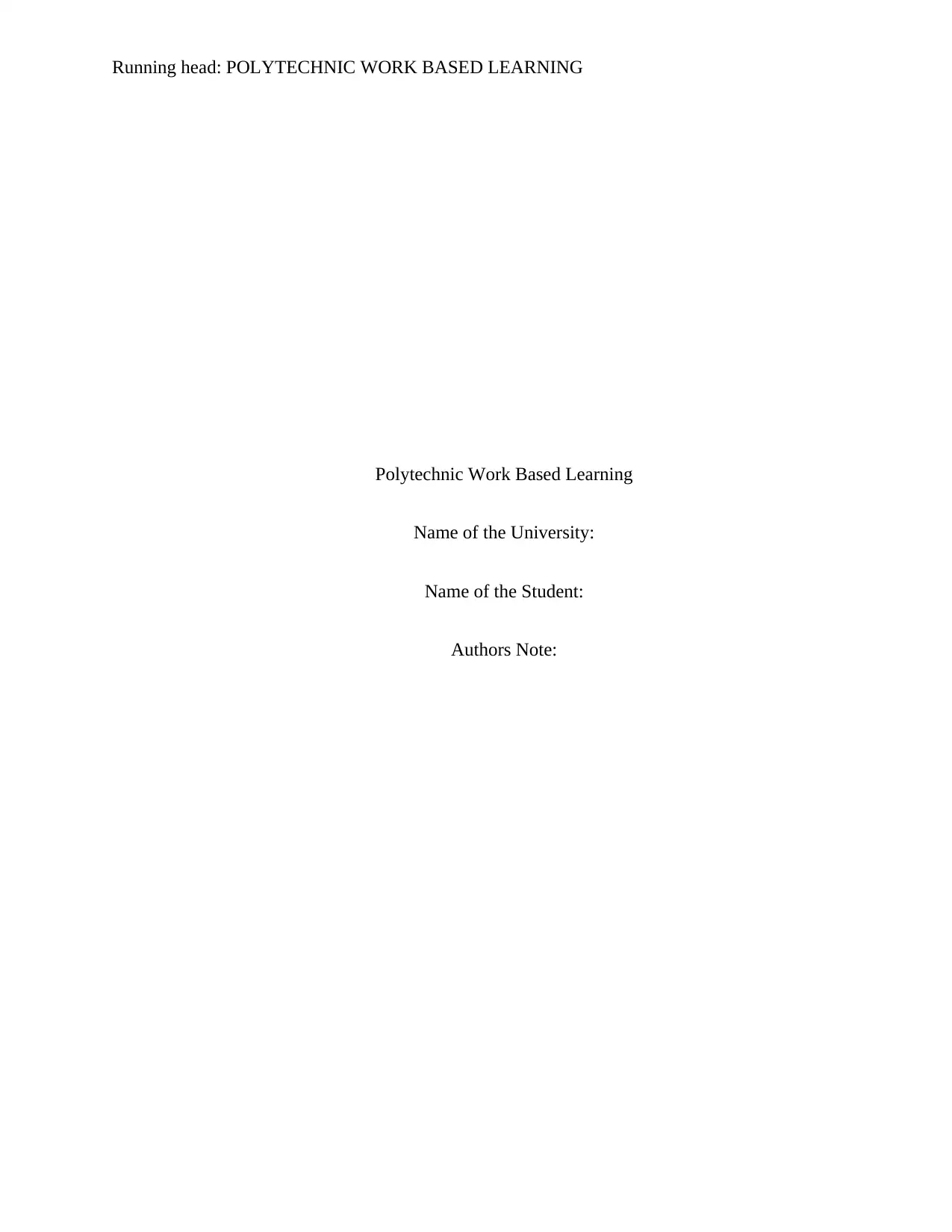
Running head: POLYTECHNIC WORK BASED LEARNING
Polytechnic Work Based Learning
Name of the University:
Name of the Student:
Authors Note:
Polytechnic Work Based Learning
Name of the University:
Name of the Student:
Authors Note:
Paraphrase This Document
Need a fresh take? Get an instant paraphrase of this document with our AI Paraphraser
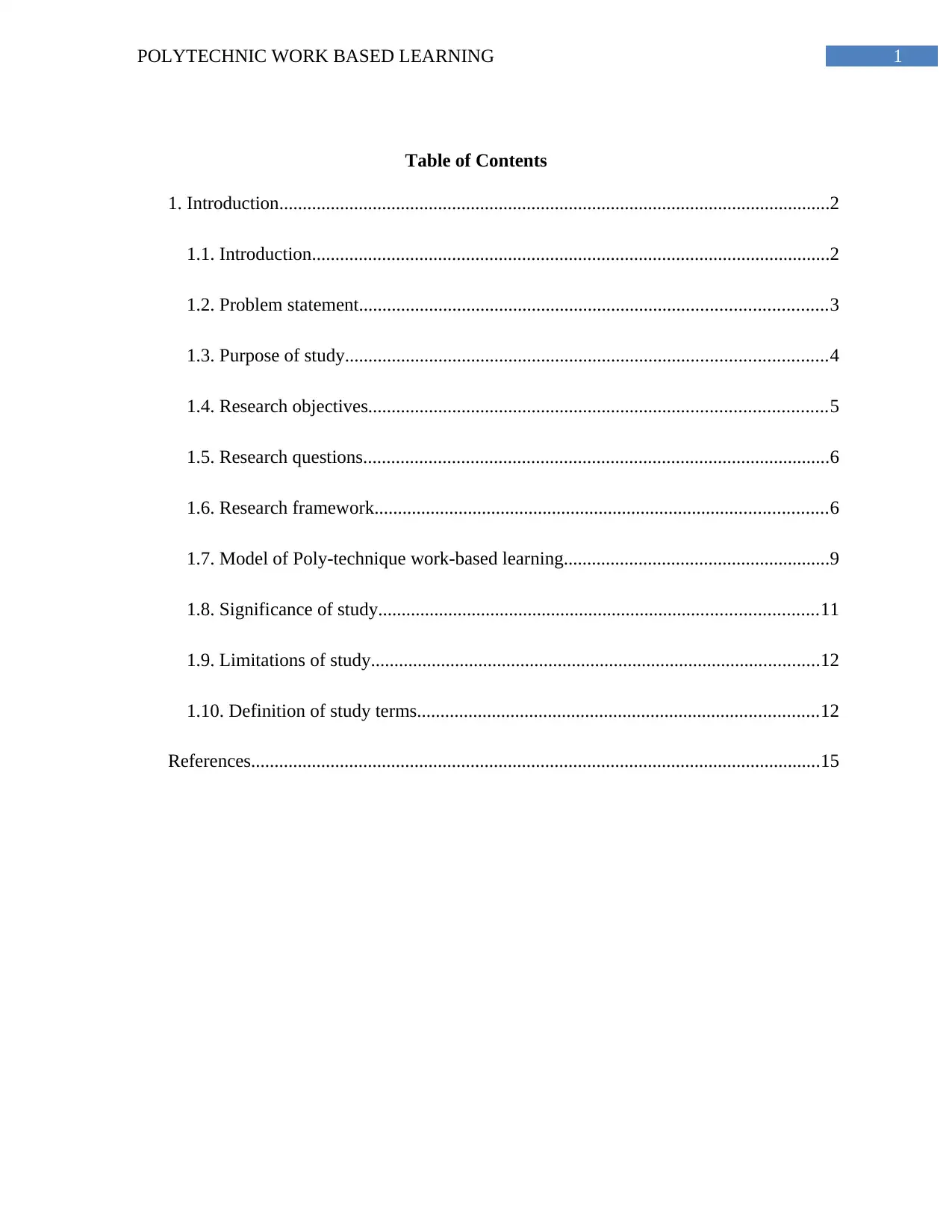
1POLYTECHNIC WORK BASED LEARNING
Table of Contents
1. Introduction......................................................................................................................2
1.1. Introduction...............................................................................................................2
1.2. Problem statement....................................................................................................3
1.3. Purpose of study.......................................................................................................4
1.4. Research objectives..................................................................................................5
1.5. Research questions....................................................................................................6
1.6. Research framework.................................................................................................6
1.7. Model of Poly-technique work-based learning.........................................................9
1.8. Significance of study..............................................................................................11
1.9. Limitations of study................................................................................................12
1.10. Definition of study terms......................................................................................12
References..........................................................................................................................15
Table of Contents
1. Introduction......................................................................................................................2
1.1. Introduction...............................................................................................................2
1.2. Problem statement....................................................................................................3
1.3. Purpose of study.......................................................................................................4
1.4. Research objectives..................................................................................................5
1.5. Research questions....................................................................................................6
1.6. Research framework.................................................................................................6
1.7. Model of Poly-technique work-based learning.........................................................9
1.8. Significance of study..............................................................................................11
1.9. Limitations of study................................................................................................12
1.10. Definition of study terms......................................................................................12
References..........................................................................................................................15
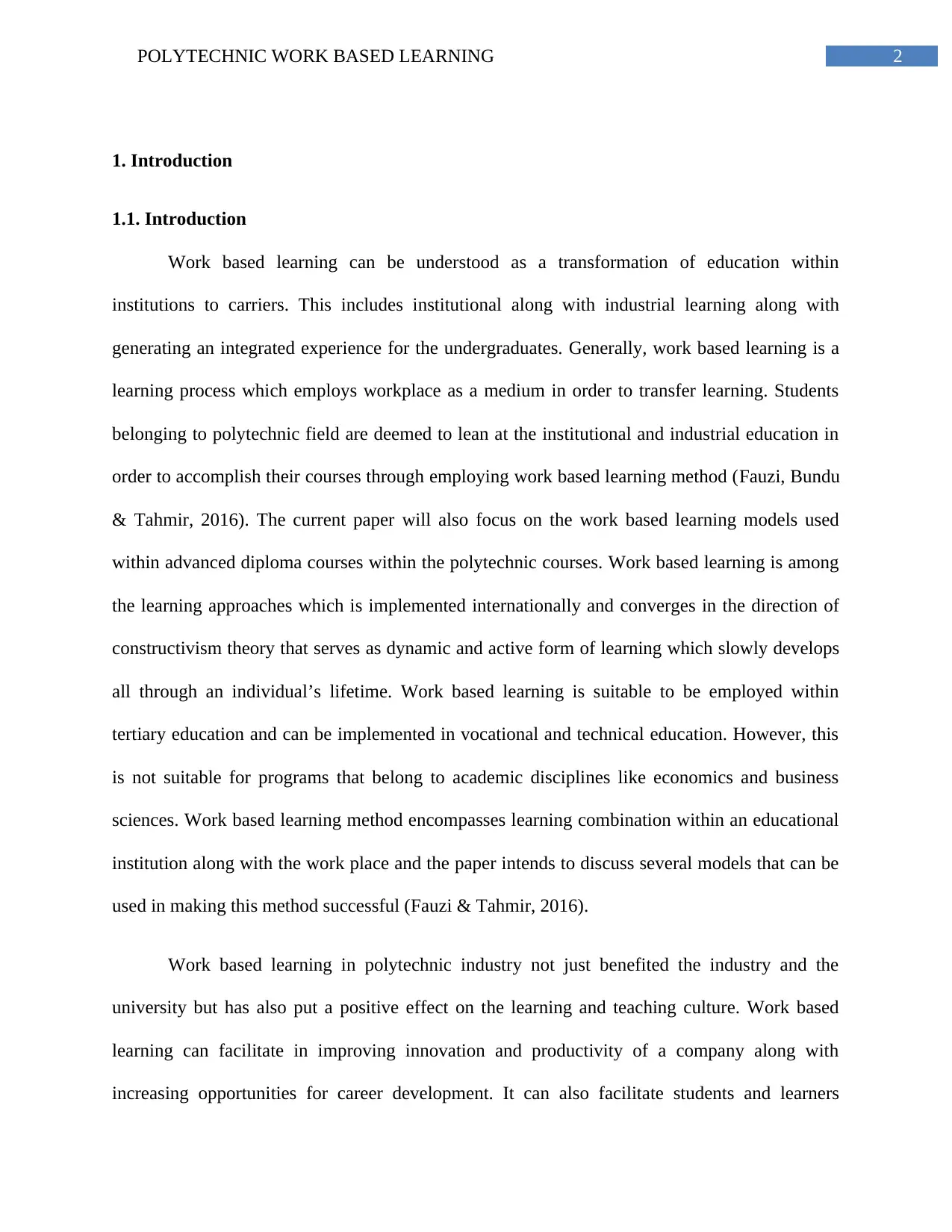
2POLYTECHNIC WORK BASED LEARNING
1. Introduction
1.1. Introduction
Work based learning can be understood as a transformation of education within
institutions to carriers. This includes institutional along with industrial learning along with
generating an integrated experience for the undergraduates. Generally, work based learning is a
learning process which employs workplace as a medium in order to transfer learning. Students
belonging to polytechnic field are deemed to lean at the institutional and industrial education in
order to accomplish their courses through employing work based learning method (Fauzi, Bundu
& Tahmir, 2016). The current paper will also focus on the work based learning models used
within advanced diploma courses within the polytechnic courses. Work based learning is among
the learning approaches which is implemented internationally and converges in the direction of
constructivism theory that serves as dynamic and active form of learning which slowly develops
all through an individual’s lifetime. Work based learning is suitable to be employed within
tertiary education and can be implemented in vocational and technical education. However, this
is not suitable for programs that belong to academic disciplines like economics and business
sciences. Work based learning method encompasses learning combination within an educational
institution along with the work place and the paper intends to discuss several models that can be
used in making this method successful (Fauzi & Tahmir, 2016).
Work based learning in polytechnic industry not just benefited the industry and the
university but has also put a positive effect on the learning and teaching culture. Work based
learning can facilitate in improving innovation and productivity of a company along with
increasing opportunities for career development. It can also facilitate students and learners
1. Introduction
1.1. Introduction
Work based learning can be understood as a transformation of education within
institutions to carriers. This includes institutional along with industrial learning along with
generating an integrated experience for the undergraduates. Generally, work based learning is a
learning process which employs workplace as a medium in order to transfer learning. Students
belonging to polytechnic field are deemed to lean at the institutional and industrial education in
order to accomplish their courses through employing work based learning method (Fauzi, Bundu
& Tahmir, 2016). The current paper will also focus on the work based learning models used
within advanced diploma courses within the polytechnic courses. Work based learning is among
the learning approaches which is implemented internationally and converges in the direction of
constructivism theory that serves as dynamic and active form of learning which slowly develops
all through an individual’s lifetime. Work based learning is suitable to be employed within
tertiary education and can be implemented in vocational and technical education. However, this
is not suitable for programs that belong to academic disciplines like economics and business
sciences. Work based learning method encompasses learning combination within an educational
institution along with the work place and the paper intends to discuss several models that can be
used in making this method successful (Fauzi & Tahmir, 2016).
Work based learning in polytechnic industry not just benefited the industry and the
university but has also put a positive effect on the learning and teaching culture. Work based
learning can facilitate in improving innovation and productivity of a company along with
increasing opportunities for career development. It can also facilitate students and learners
⊘ This is a preview!⊘
Do you want full access?
Subscribe today to unlock all pages.

Trusted by 1+ million students worldwide
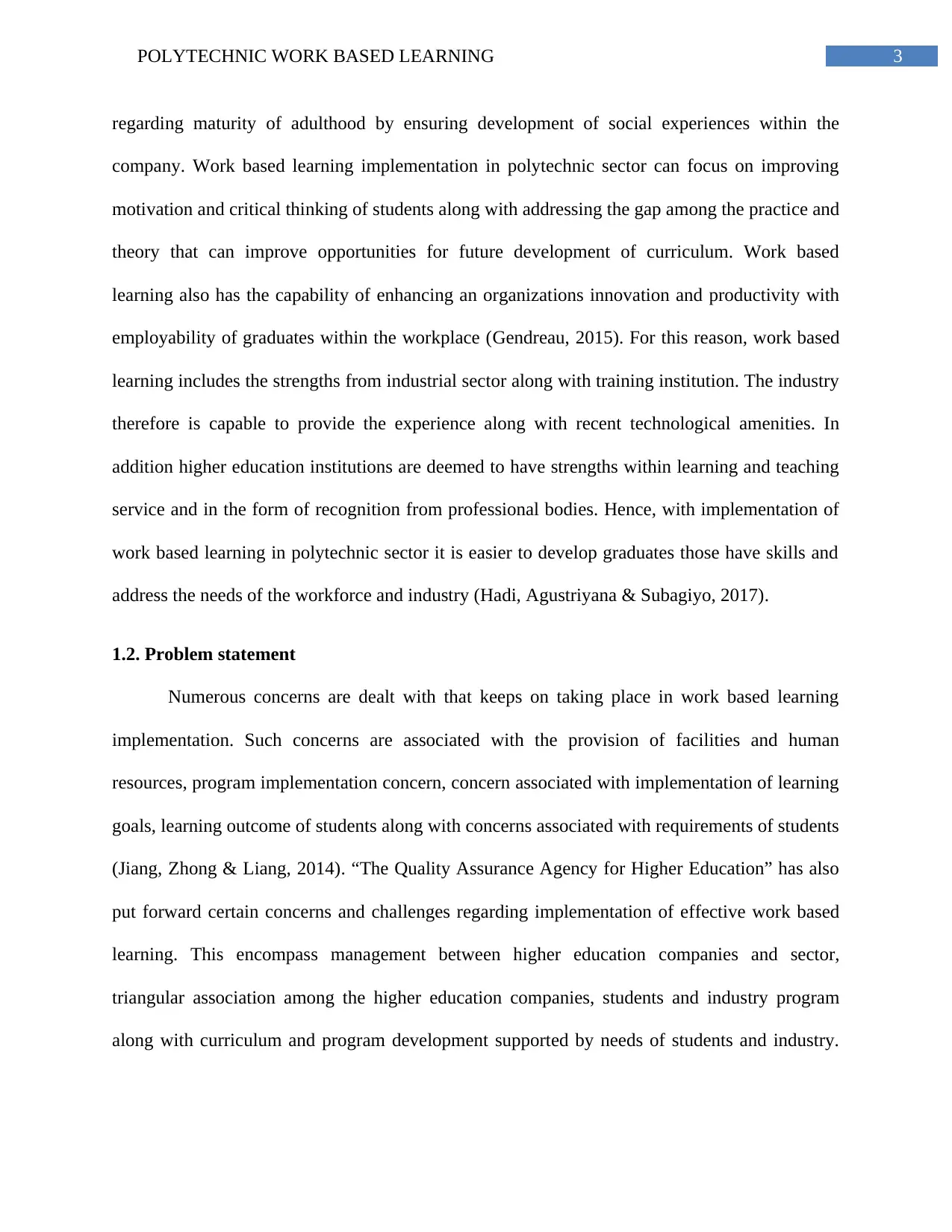
3POLYTECHNIC WORK BASED LEARNING
regarding maturity of adulthood by ensuring development of social experiences within the
company. Work based learning implementation in polytechnic sector can focus on improving
motivation and critical thinking of students along with addressing the gap among the practice and
theory that can improve opportunities for future development of curriculum. Work based
learning also has the capability of enhancing an organizations innovation and productivity with
employability of graduates within the workplace (Gendreau, 2015). For this reason, work based
learning includes the strengths from industrial sector along with training institution. The industry
therefore is capable to provide the experience along with recent technological amenities. In
addition higher education institutions are deemed to have strengths within learning and teaching
service and in the form of recognition from professional bodies. Hence, with implementation of
work based learning in polytechnic sector it is easier to develop graduates those have skills and
address the needs of the workforce and industry (Hadi, Agustriyana & Subagiyo, 2017).
1.2. Problem statement
Numerous concerns are dealt with that keeps on taking place in work based learning
implementation. Such concerns are associated with the provision of facilities and human
resources, program implementation concern, concern associated with implementation of learning
goals, learning outcome of students along with concerns associated with requirements of students
(Jiang, Zhong & Liang, 2014). “The Quality Assurance Agency for Higher Education” has also
put forward certain concerns and challenges regarding implementation of effective work based
learning. This encompass management between higher education companies and sector,
triangular association among the higher education companies, students and industry program
along with curriculum and program development supported by needs of students and industry.
regarding maturity of adulthood by ensuring development of social experiences within the
company. Work based learning implementation in polytechnic sector can focus on improving
motivation and critical thinking of students along with addressing the gap among the practice and
theory that can improve opportunities for future development of curriculum. Work based
learning also has the capability of enhancing an organizations innovation and productivity with
employability of graduates within the workplace (Gendreau, 2015). For this reason, work based
learning includes the strengths from industrial sector along with training institution. The industry
therefore is capable to provide the experience along with recent technological amenities. In
addition higher education institutions are deemed to have strengths within learning and teaching
service and in the form of recognition from professional bodies. Hence, with implementation of
work based learning in polytechnic sector it is easier to develop graduates those have skills and
address the needs of the workforce and industry (Hadi, Agustriyana & Subagiyo, 2017).
1.2. Problem statement
Numerous concerns are dealt with that keeps on taking place in work based learning
implementation. Such concerns are associated with the provision of facilities and human
resources, program implementation concern, concern associated with implementation of learning
goals, learning outcome of students along with concerns associated with requirements of students
(Jiang, Zhong & Liang, 2014). “The Quality Assurance Agency for Higher Education” has also
put forward certain concerns and challenges regarding implementation of effective work based
learning. This encompass management between higher education companies and sector,
triangular association among the higher education companies, students and industry program
along with curriculum and program development supported by needs of students and industry.
Paraphrase This Document
Need a fresh take? Get an instant paraphrase of this document with our AI Paraphraser
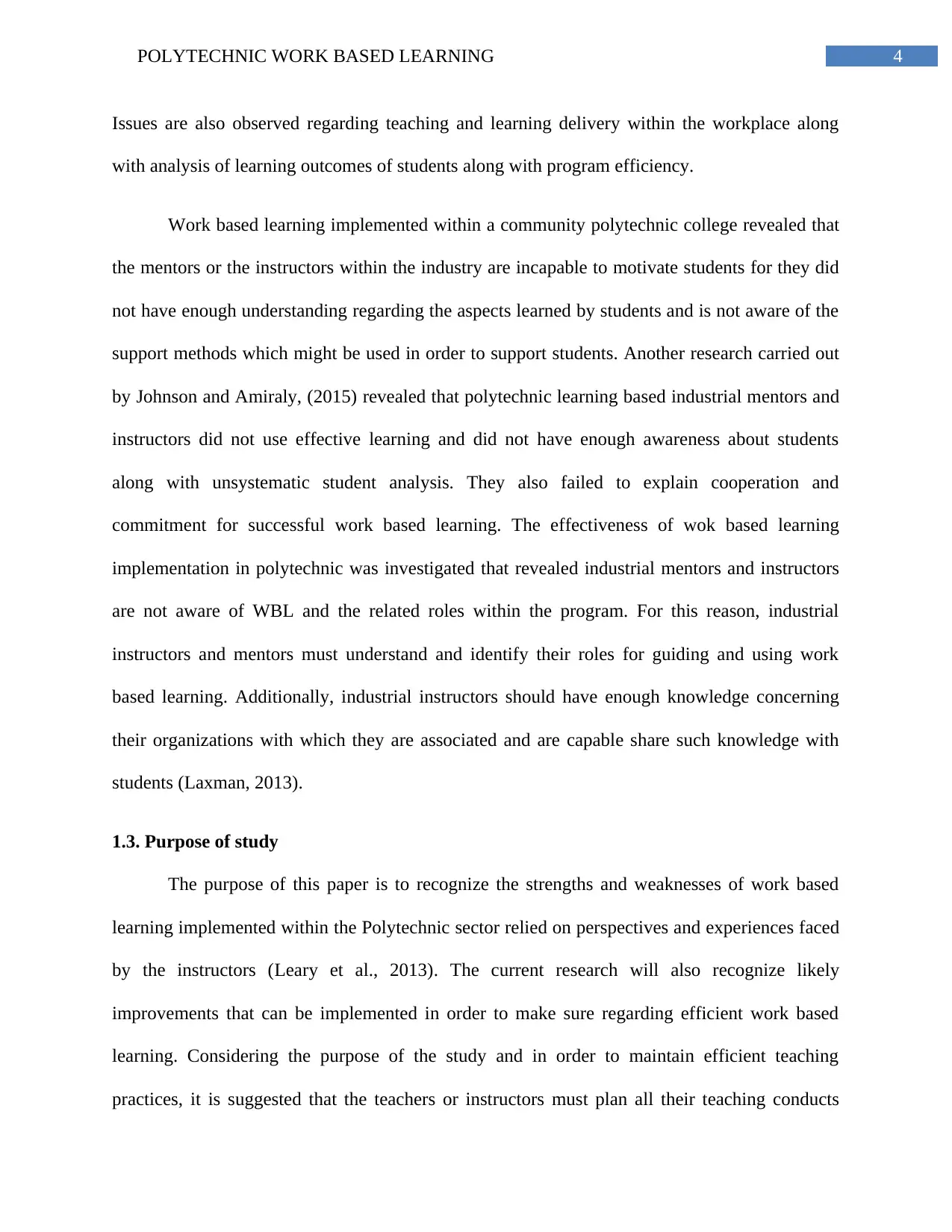
4POLYTECHNIC WORK BASED LEARNING
Issues are also observed regarding teaching and learning delivery within the workplace along
with analysis of learning outcomes of students along with program efficiency.
Work based learning implemented within a community polytechnic college revealed that
the mentors or the instructors within the industry are incapable to motivate students for they did
not have enough understanding regarding the aspects learned by students and is not aware of the
support methods which might be used in order to support students. Another research carried out
by Johnson and Amiraly, (2015) revealed that polytechnic learning based industrial mentors and
instructors did not use effective learning and did not have enough awareness about students
along with unsystematic student analysis. They also failed to explain cooperation and
commitment for successful work based learning. The effectiveness of wok based learning
implementation in polytechnic was investigated that revealed industrial mentors and instructors
are not aware of WBL and the related roles within the program. For this reason, industrial
instructors and mentors must understand and identify their roles for guiding and using work
based learning. Additionally, industrial instructors should have enough knowledge concerning
their organizations with which they are associated and are capable share such knowledge with
students (Laxman, 2013).
1.3. Purpose of study
The purpose of this paper is to recognize the strengths and weaknesses of work based
learning implemented within the Polytechnic sector relied on perspectives and experiences faced
by the instructors (Leary et al., 2013). The current research will also recognize likely
improvements that can be implemented in order to make sure regarding efficient work based
learning. Considering the purpose of the study and in order to maintain efficient teaching
practices, it is suggested that the teachers or instructors must plan all their teaching conducts
Issues are also observed regarding teaching and learning delivery within the workplace along
with analysis of learning outcomes of students along with program efficiency.
Work based learning implemented within a community polytechnic college revealed that
the mentors or the instructors within the industry are incapable to motivate students for they did
not have enough understanding regarding the aspects learned by students and is not aware of the
support methods which might be used in order to support students. Another research carried out
by Johnson and Amiraly, (2015) revealed that polytechnic learning based industrial mentors and
instructors did not use effective learning and did not have enough awareness about students
along with unsystematic student analysis. They also failed to explain cooperation and
commitment for successful work based learning. The effectiveness of wok based learning
implementation in polytechnic was investigated that revealed industrial mentors and instructors
are not aware of WBL and the related roles within the program. For this reason, industrial
instructors and mentors must understand and identify their roles for guiding and using work
based learning. Additionally, industrial instructors should have enough knowledge concerning
their organizations with which they are associated and are capable share such knowledge with
students (Laxman, 2013).
1.3. Purpose of study
The purpose of this paper is to recognize the strengths and weaknesses of work based
learning implemented within the Polytechnic sector relied on perspectives and experiences faced
by the instructors (Leary et al., 2013). The current research will also recognize likely
improvements that can be implemented in order to make sure regarding efficient work based
learning. Considering the purpose of the study and in order to maintain efficient teaching
practices, it is suggested that the teachers or instructors must plan all their teaching conducts
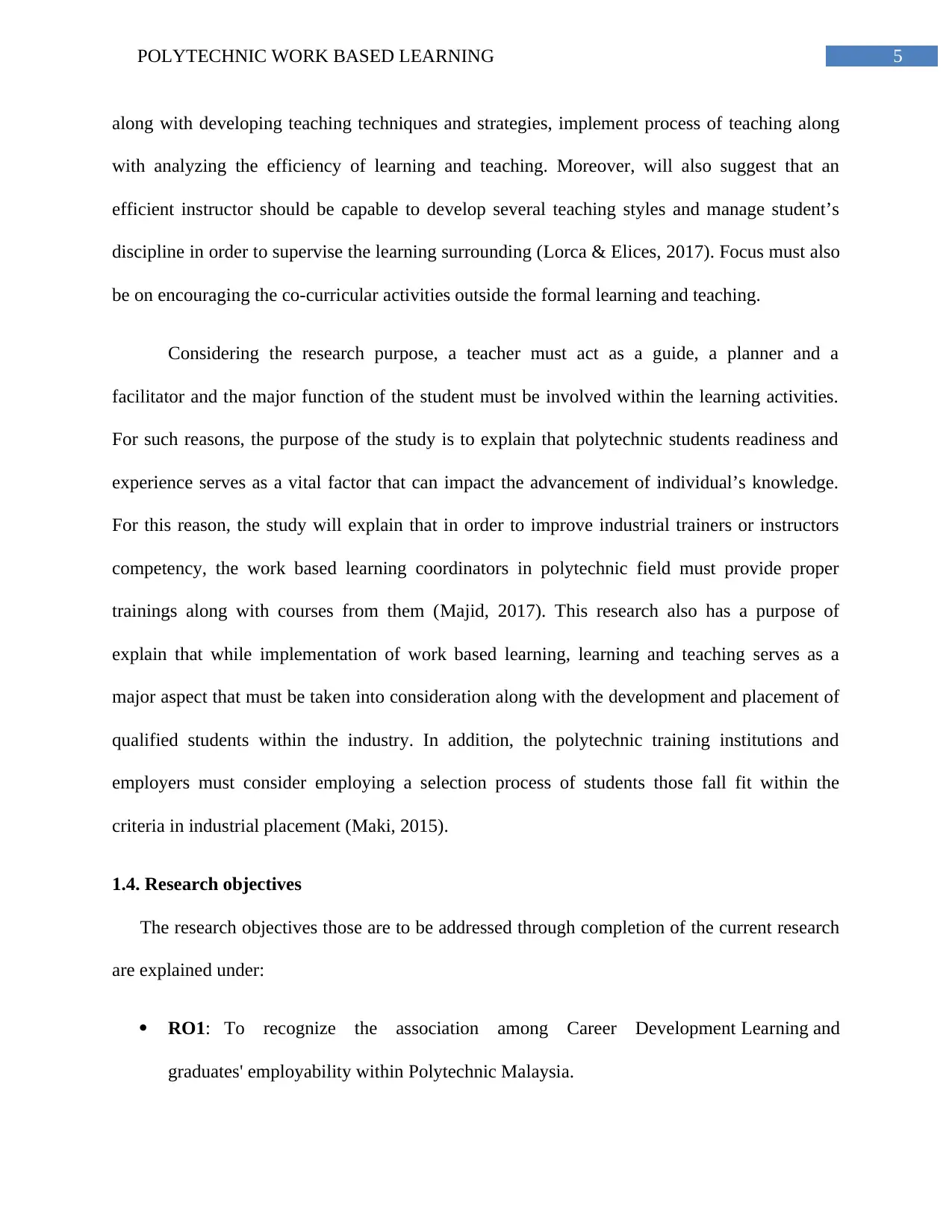
5POLYTECHNIC WORK BASED LEARNING
along with developing teaching techniques and strategies, implement process of teaching along
with analyzing the efficiency of learning and teaching. Moreover, will also suggest that an
efficient instructor should be capable to develop several teaching styles and manage student’s
discipline in order to supervise the learning surrounding (Lorca & Elices, 2017). Focus must also
be on encouraging the co-curricular activities outside the formal learning and teaching.
Considering the research purpose, a teacher must act as a guide, a planner and a
facilitator and the major function of the student must be involved within the learning activities.
For such reasons, the purpose of the study is to explain that polytechnic students readiness and
experience serves as a vital factor that can impact the advancement of individual’s knowledge.
For this reason, the study will explain that in order to improve industrial trainers or instructors
competency, the work based learning coordinators in polytechnic field must provide proper
trainings along with courses from them (Majid, 2017). This research also has a purpose of
explain that while implementation of work based learning, learning and teaching serves as a
major aspect that must be taken into consideration along with the development and placement of
qualified students within the industry. In addition, the polytechnic training institutions and
employers must consider employing a selection process of students those fall fit within the
criteria in industrial placement (Maki, 2015).
1.4. Research objectives
The research objectives those are to be addressed through completion of the current research
are explained under:
RO1: To recognize the association among Career Development Learning and
graduates' employability within Polytechnic Malaysia.
along with developing teaching techniques and strategies, implement process of teaching along
with analyzing the efficiency of learning and teaching. Moreover, will also suggest that an
efficient instructor should be capable to develop several teaching styles and manage student’s
discipline in order to supervise the learning surrounding (Lorca & Elices, 2017). Focus must also
be on encouraging the co-curricular activities outside the formal learning and teaching.
Considering the research purpose, a teacher must act as a guide, a planner and a
facilitator and the major function of the student must be involved within the learning activities.
For such reasons, the purpose of the study is to explain that polytechnic students readiness and
experience serves as a vital factor that can impact the advancement of individual’s knowledge.
For this reason, the study will explain that in order to improve industrial trainers or instructors
competency, the work based learning coordinators in polytechnic field must provide proper
trainings along with courses from them (Majid, 2017). This research also has a purpose of
explain that while implementation of work based learning, learning and teaching serves as a
major aspect that must be taken into consideration along with the development and placement of
qualified students within the industry. In addition, the polytechnic training institutions and
employers must consider employing a selection process of students those fall fit within the
criteria in industrial placement (Maki, 2015).
1.4. Research objectives
The research objectives those are to be addressed through completion of the current research
are explained under:
RO1: To recognize the association among Career Development Learning and
graduates' employability within Polytechnic Malaysia.
⊘ This is a preview!⊘
Do you want full access?
Subscribe today to unlock all pages.

Trusted by 1+ million students worldwide
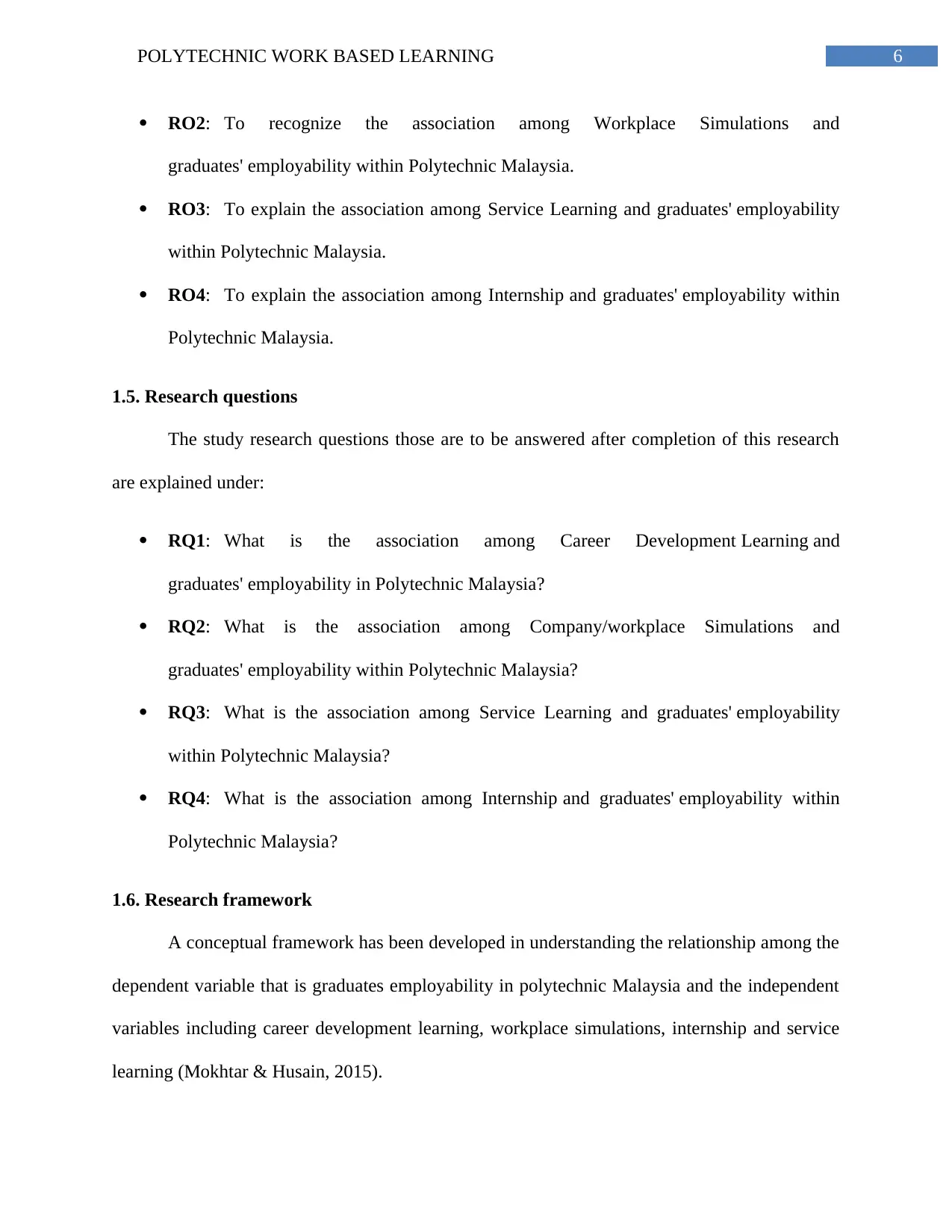
6POLYTECHNIC WORK BASED LEARNING
RO2: To recognize the association among Workplace Simulations and
graduates' employability within Polytechnic Malaysia.
RO3: To explain the association among Service Learning and graduates' employability
within Polytechnic Malaysia.
RO4: To explain the association among Internship and graduates' employability within
Polytechnic Malaysia.
1.5. Research questions
The study research questions those are to be answered after completion of this research
are explained under:
RQ1: What is the association among Career Development Learning and
graduates' employability in Polytechnic Malaysia?
RQ2: What is the association among Company/workplace Simulations and
graduates' employability within Polytechnic Malaysia?
RQ3: What is the association among Service Learning and graduates' employability
within Polytechnic Malaysia?
RQ4: What is the association among Internship and graduates' employability within
Polytechnic Malaysia?
1.6. Research framework
A conceptual framework has been developed in understanding the relationship among the
dependent variable that is graduates employability in polytechnic Malaysia and the independent
variables including career development learning, workplace simulations, internship and service
learning (Mokhtar & Husain, 2015).
RO2: To recognize the association among Workplace Simulations and
graduates' employability within Polytechnic Malaysia.
RO3: To explain the association among Service Learning and graduates' employability
within Polytechnic Malaysia.
RO4: To explain the association among Internship and graduates' employability within
Polytechnic Malaysia.
1.5. Research questions
The study research questions those are to be answered after completion of this research
are explained under:
RQ1: What is the association among Career Development Learning and
graduates' employability in Polytechnic Malaysia?
RQ2: What is the association among Company/workplace Simulations and
graduates' employability within Polytechnic Malaysia?
RQ3: What is the association among Service Learning and graduates' employability
within Polytechnic Malaysia?
RQ4: What is the association among Internship and graduates' employability within
Polytechnic Malaysia?
1.6. Research framework
A conceptual framework has been developed in understanding the relationship among the
dependent variable that is graduates employability in polytechnic Malaysia and the independent
variables including career development learning, workplace simulations, internship and service
learning (Mokhtar & Husain, 2015).
Paraphrase This Document
Need a fresh take? Get an instant paraphrase of this document with our AI Paraphraser
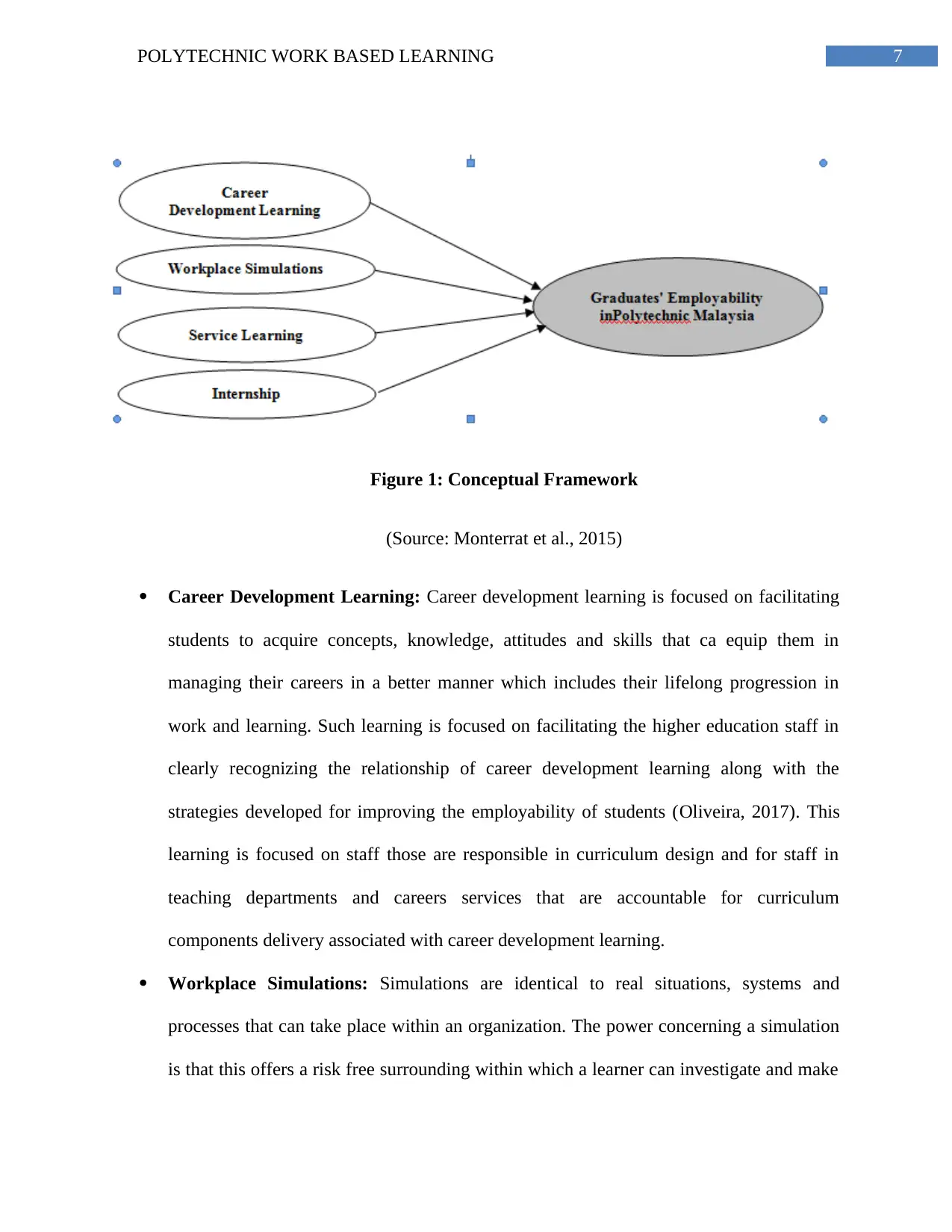
7POLYTECHNIC WORK BASED LEARNING
Figure 1: Conceptual Framework
(Source: Monterrat et al., 2015)
Career Development Learning: Career development learning is focused on facilitating
students to acquire concepts, knowledge, attitudes and skills that ca equip them in
managing their careers in a better manner which includes their lifelong progression in
work and learning. Such learning is focused on facilitating the higher education staff in
clearly recognizing the relationship of career development learning along with the
strategies developed for improving the employability of students (Oliveira, 2017). This
learning is focused on staff those are responsible in curriculum design and for staff in
teaching departments and careers services that are accountable for curriculum
components delivery associated with career development learning.
Workplace Simulations: Simulations are identical to real situations, systems and
processes that can take place within an organization. The power concerning a simulation
is that this offers a risk free surrounding within which a learner can investigate and make
Figure 1: Conceptual Framework
(Source: Monterrat et al., 2015)
Career Development Learning: Career development learning is focused on facilitating
students to acquire concepts, knowledge, attitudes and skills that ca equip them in
managing their careers in a better manner which includes their lifelong progression in
work and learning. Such learning is focused on facilitating the higher education staff in
clearly recognizing the relationship of career development learning along with the
strategies developed for improving the employability of students (Oliveira, 2017). This
learning is focused on staff those are responsible in curriculum design and for staff in
teaching departments and careers services that are accountable for curriculum
components delivery associated with career development learning.
Workplace Simulations: Simulations are identical to real situations, systems and
processes that can take place within an organization. The power concerning a simulation
is that this offers a risk free surrounding within which a learner can investigate and make
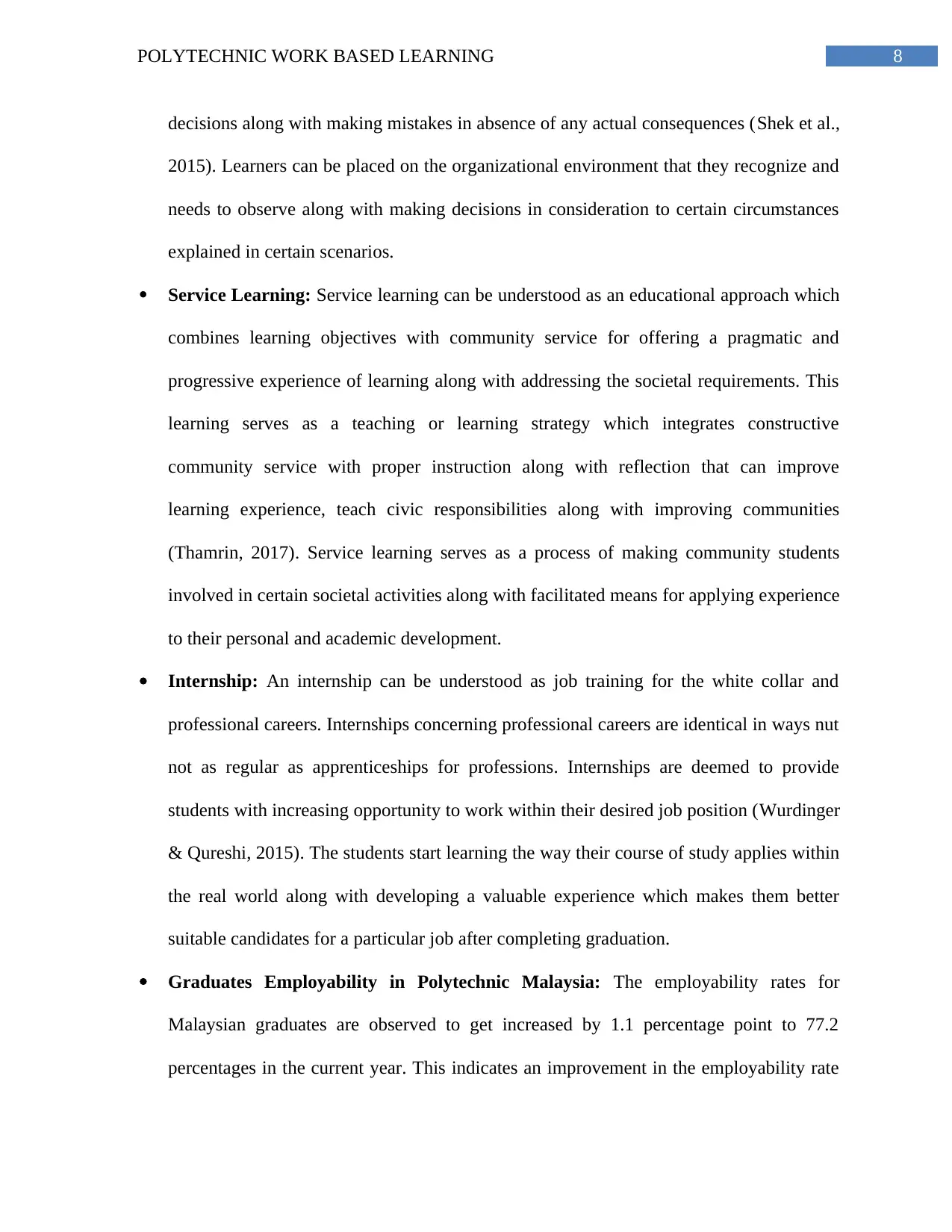
8POLYTECHNIC WORK BASED LEARNING
decisions along with making mistakes in absence of any actual consequences (Shek et al.,
2015). Learners can be placed on the organizational environment that they recognize and
needs to observe along with making decisions in consideration to certain circumstances
explained in certain scenarios.
Service Learning: Service learning can be understood as an educational approach which
combines learning objectives with community service for offering a pragmatic and
progressive experience of learning along with addressing the societal requirements. This
learning serves as a teaching or learning strategy which integrates constructive
community service with proper instruction along with reflection that can improve
learning experience, teach civic responsibilities along with improving communities
(Thamrin, 2017). Service learning serves as a process of making community students
involved in certain societal activities along with facilitated means for applying experience
to their personal and academic development.
Internship: An internship can be understood as job training for the white collar and
professional careers. Internships concerning professional careers are identical in ways nut
not as regular as apprenticeships for professions. Internships are deemed to provide
students with increasing opportunity to work within their desired job position (Wurdinger
& Qureshi, 2015). The students start learning the way their course of study applies within
the real world along with developing a valuable experience which makes them better
suitable candidates for a particular job after completing graduation.
Graduates Employability in Polytechnic Malaysia: The employability rates for
Malaysian graduates are observed to get increased by 1.1 percentage point to 77.2
percentages in the current year. This indicates an improvement in the employability rate
decisions along with making mistakes in absence of any actual consequences (Shek et al.,
2015). Learners can be placed on the organizational environment that they recognize and
needs to observe along with making decisions in consideration to certain circumstances
explained in certain scenarios.
Service Learning: Service learning can be understood as an educational approach which
combines learning objectives with community service for offering a pragmatic and
progressive experience of learning along with addressing the societal requirements. This
learning serves as a teaching or learning strategy which integrates constructive
community service with proper instruction along with reflection that can improve
learning experience, teach civic responsibilities along with improving communities
(Thamrin, 2017). Service learning serves as a process of making community students
involved in certain societal activities along with facilitated means for applying experience
to their personal and academic development.
Internship: An internship can be understood as job training for the white collar and
professional careers. Internships concerning professional careers are identical in ways nut
not as regular as apprenticeships for professions. Internships are deemed to provide
students with increasing opportunity to work within their desired job position (Wurdinger
& Qureshi, 2015). The students start learning the way their course of study applies within
the real world along with developing a valuable experience which makes them better
suitable candidates for a particular job after completing graduation.
Graduates Employability in Polytechnic Malaysia: The employability rates for
Malaysian graduates are observed to get increased by 1.1 percentage point to 77.2
percentages in the current year. This indicates an improvement in the employability rate
⊘ This is a preview!⊘
Do you want full access?
Subscribe today to unlock all pages.

Trusted by 1+ million students worldwide
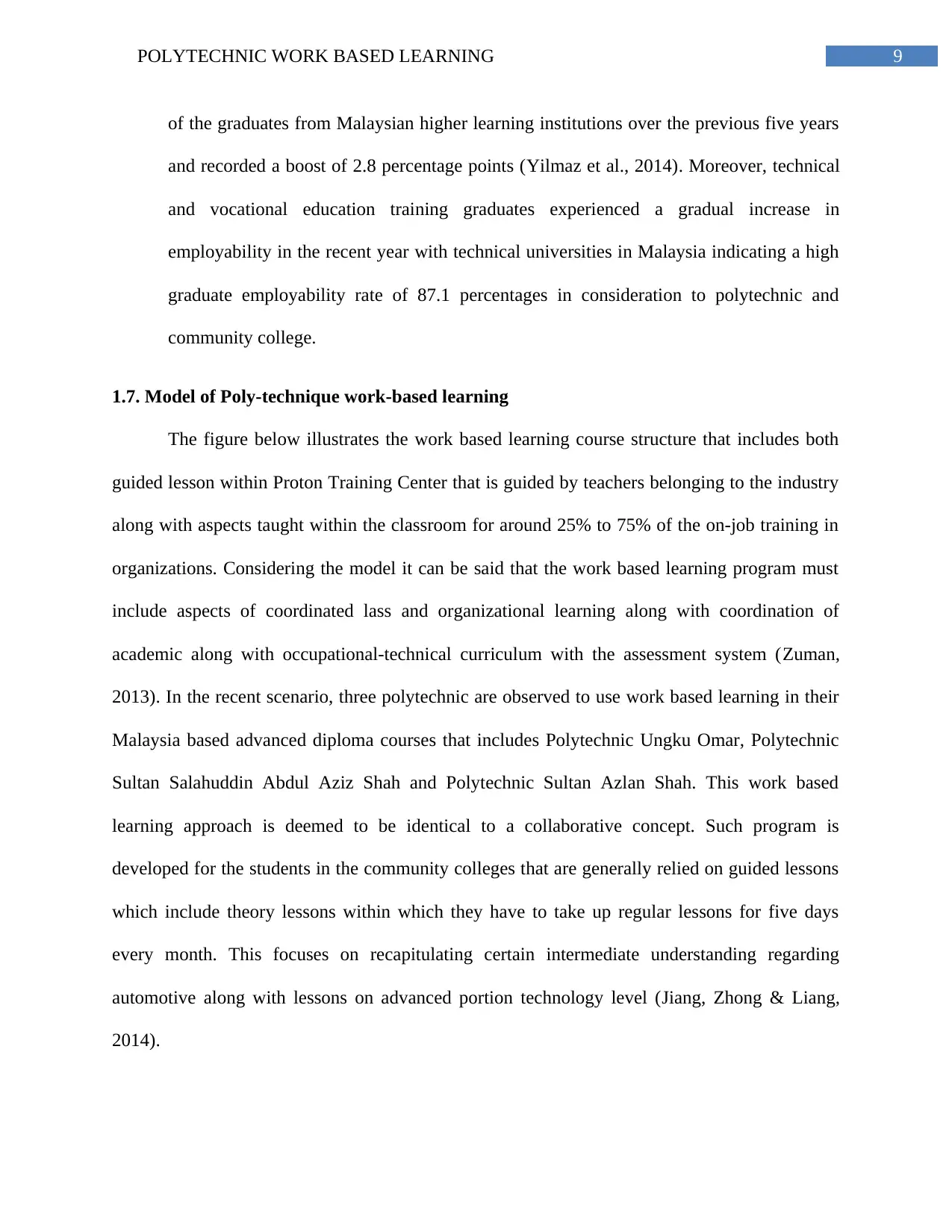
9POLYTECHNIC WORK BASED LEARNING
of the graduates from Malaysian higher learning institutions over the previous five years
and recorded a boost of 2.8 percentage points (Yilmaz et al., 2014). Moreover, technical
and vocational education training graduates experienced a gradual increase in
employability in the recent year with technical universities in Malaysia indicating a high
graduate employability rate of 87.1 percentages in consideration to polytechnic and
community college.
1.7. Model of Poly-technique work-based learning
The figure below illustrates the work based learning course structure that includes both
guided lesson within Proton Training Center that is guided by teachers belonging to the industry
along with aspects taught within the classroom for around 25% to 75% of the on-job training in
organizations. Considering the model it can be said that the work based learning program must
include aspects of coordinated lass and organizational learning along with coordination of
academic along with occupational-technical curriculum with the assessment system (Zuman,
2013). In the recent scenario, three polytechnic are observed to use work based learning in their
Malaysia based advanced diploma courses that includes Polytechnic Ungku Omar, Polytechnic
Sultan Salahuddin Abdul Aziz Shah and Polytechnic Sultan Azlan Shah. This work based
learning approach is deemed to be identical to a collaborative concept. Such program is
developed for the students in the community colleges that are generally relied on guided lessons
which include theory lessons within which they have to take up regular lessons for five days
every month. This focuses on recapitulating certain intermediate understanding regarding
automotive along with lessons on advanced portion technology level (Jiang, Zhong & Liang,
2014).
of the graduates from Malaysian higher learning institutions over the previous five years
and recorded a boost of 2.8 percentage points (Yilmaz et al., 2014). Moreover, technical
and vocational education training graduates experienced a gradual increase in
employability in the recent year with technical universities in Malaysia indicating a high
graduate employability rate of 87.1 percentages in consideration to polytechnic and
community college.
1.7. Model of Poly-technique work-based learning
The figure below illustrates the work based learning course structure that includes both
guided lesson within Proton Training Center that is guided by teachers belonging to the industry
along with aspects taught within the classroom for around 25% to 75% of the on-job training in
organizations. Considering the model it can be said that the work based learning program must
include aspects of coordinated lass and organizational learning along with coordination of
academic along with occupational-technical curriculum with the assessment system (Zuman,
2013). In the recent scenario, three polytechnic are observed to use work based learning in their
Malaysia based advanced diploma courses that includes Polytechnic Ungku Omar, Polytechnic
Sultan Salahuddin Abdul Aziz Shah and Polytechnic Sultan Azlan Shah. This work based
learning approach is deemed to be identical to a collaborative concept. Such program is
developed for the students in the community colleges that are generally relied on guided lessons
which include theory lessons within which they have to take up regular lessons for five days
every month. This focuses on recapitulating certain intermediate understanding regarding
automotive along with lessons on advanced portion technology level (Jiang, Zhong & Liang,
2014).
Paraphrase This Document
Need a fresh take? Get an instant paraphrase of this document with our AI Paraphraser
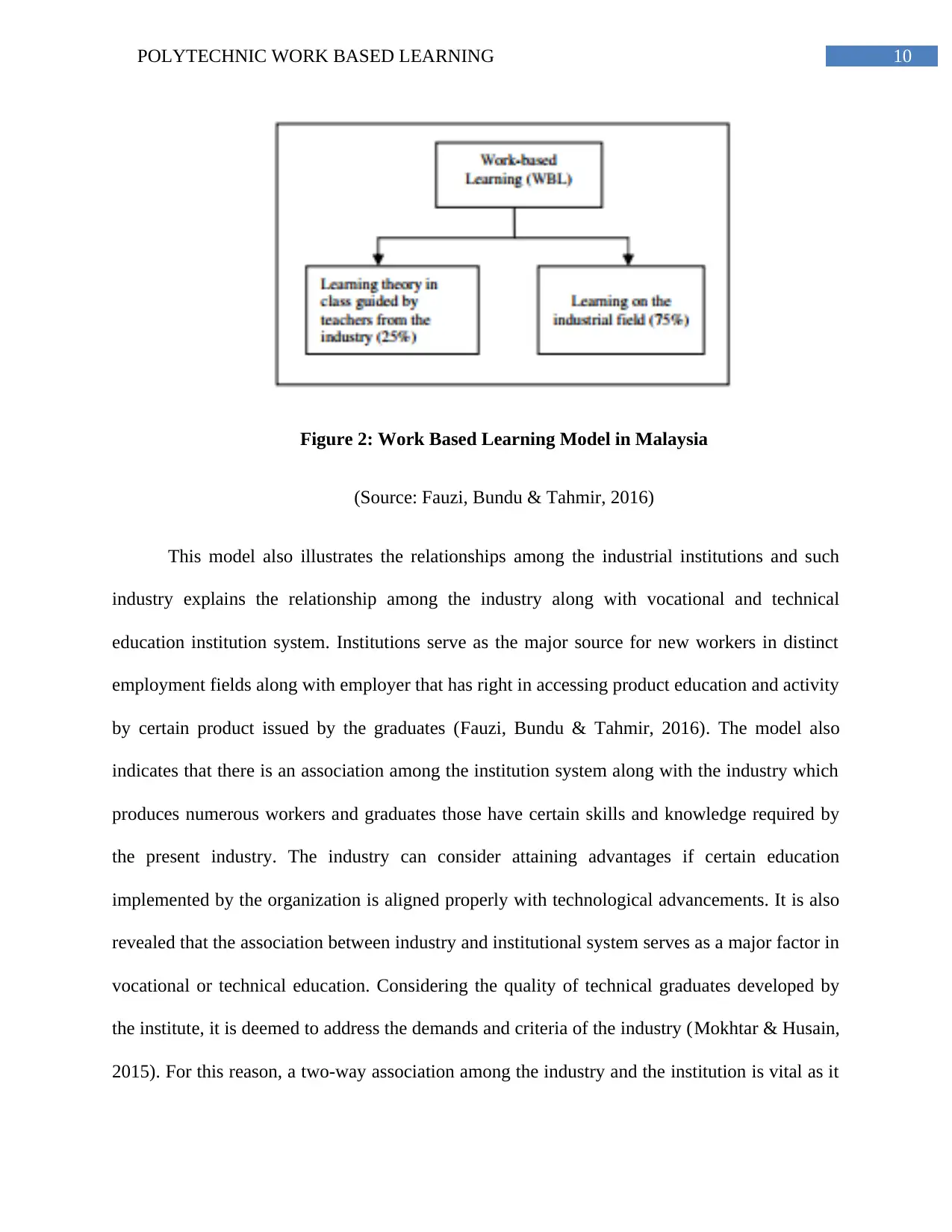
10POLYTECHNIC WORK BASED LEARNING
Figure 2: Work Based Learning Model in Malaysia
(Source: Fauzi, Bundu & Tahmir, 2016)
This model also illustrates the relationships among the industrial institutions and such
industry explains the relationship among the industry along with vocational and technical
education institution system. Institutions serve as the major source for new workers in distinct
employment fields along with employer that has right in accessing product education and activity
by certain product issued by the graduates (Fauzi, Bundu & Tahmir, 2016). The model also
indicates that there is an association among the institution system along with the industry which
produces numerous workers and graduates those have certain skills and knowledge required by
the present industry. The industry can consider attaining advantages if certain education
implemented by the organization is aligned properly with technological advancements. It is also
revealed that the association between industry and institutional system serves as a major factor in
vocational or technical education. Considering the quality of technical graduates developed by
the institute, it is deemed to address the demands and criteria of the industry (Mokhtar & Husain,
2015). For this reason, a two-way association among the industry and the institution is vital as it
Figure 2: Work Based Learning Model in Malaysia
(Source: Fauzi, Bundu & Tahmir, 2016)
This model also illustrates the relationships among the industrial institutions and such
industry explains the relationship among the industry along with vocational and technical
education institution system. Institutions serve as the major source for new workers in distinct
employment fields along with employer that has right in accessing product education and activity
by certain product issued by the graduates (Fauzi, Bundu & Tahmir, 2016). The model also
indicates that there is an association among the institution system along with the industry which
produces numerous workers and graduates those have certain skills and knowledge required by
the present industry. The industry can consider attaining advantages if certain education
implemented by the organization is aligned properly with technological advancements. It is also
revealed that the association between industry and institutional system serves as a major factor in
vocational or technical education. Considering the quality of technical graduates developed by
the institute, it is deemed to address the demands and criteria of the industry (Mokhtar & Husain,
2015). For this reason, a two-way association among the industry and the institution is vital as it
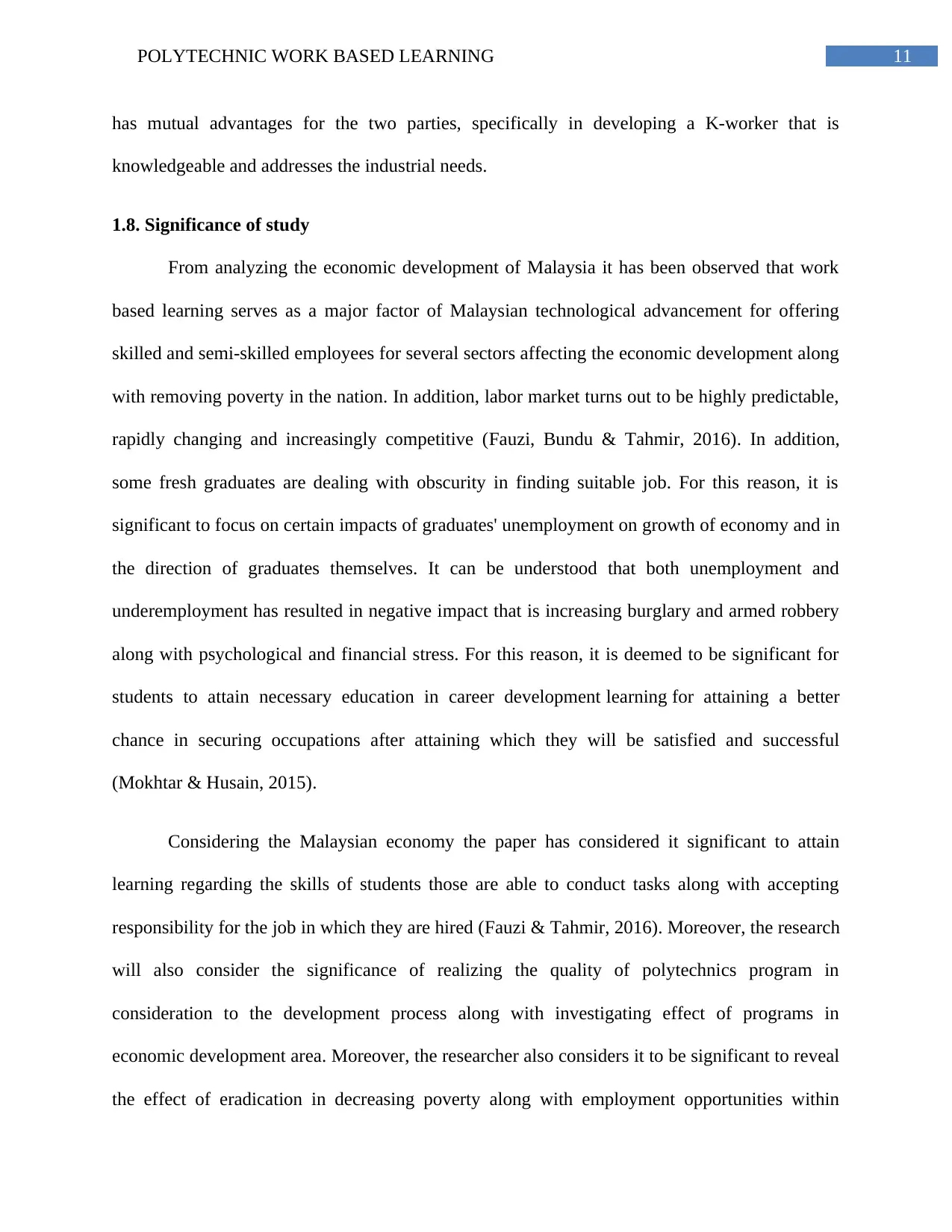
11POLYTECHNIC WORK BASED LEARNING
has mutual advantages for the two parties, specifically in developing a K-worker that is
knowledgeable and addresses the industrial needs.
1.8. Significance of study
From analyzing the economic development of Malaysia it has been observed that work
based learning serves as a major factor of Malaysian technological advancement for offering
skilled and semi-skilled employees for several sectors affecting the economic development along
with removing poverty in the nation. In addition, labor market turns out to be highly predictable,
rapidly changing and increasingly competitive (Fauzi, Bundu & Tahmir, 2016). In addition,
some fresh graduates are dealing with obscurity in finding suitable job. For this reason, it is
significant to focus on certain impacts of graduates' unemployment on growth of economy and in
the direction of graduates themselves. It can be understood that both unemployment and
underemployment has resulted in negative impact that is increasing burglary and armed robbery
along with psychological and financial stress. For this reason, it is deemed to be significant for
students to attain necessary education in career development learning for attaining a better
chance in securing occupations after attaining which they will be satisfied and successful
(Mokhtar & Husain, 2015).
Considering the Malaysian economy the paper has considered it significant to attain
learning regarding the skills of students those are able to conduct tasks along with accepting
responsibility for the job in which they are hired (Fauzi & Tahmir, 2016). Moreover, the research
will also consider the significance of realizing the quality of polytechnics program in
consideration to the development process along with investigating effect of programs in
economic development area. Moreover, the researcher also considers it to be significant to reveal
the effect of eradication in decreasing poverty along with employment opportunities within
has mutual advantages for the two parties, specifically in developing a K-worker that is
knowledgeable and addresses the industrial needs.
1.8. Significance of study
From analyzing the economic development of Malaysia it has been observed that work
based learning serves as a major factor of Malaysian technological advancement for offering
skilled and semi-skilled employees for several sectors affecting the economic development along
with removing poverty in the nation. In addition, labor market turns out to be highly predictable,
rapidly changing and increasingly competitive (Fauzi, Bundu & Tahmir, 2016). In addition,
some fresh graduates are dealing with obscurity in finding suitable job. For this reason, it is
significant to focus on certain impacts of graduates' unemployment on growth of economy and in
the direction of graduates themselves. It can be understood that both unemployment and
underemployment has resulted in negative impact that is increasing burglary and armed robbery
along with psychological and financial stress. For this reason, it is deemed to be significant for
students to attain necessary education in career development learning for attaining a better
chance in securing occupations after attaining which they will be satisfied and successful
(Mokhtar & Husain, 2015).
Considering the Malaysian economy the paper has considered it significant to attain
learning regarding the skills of students those are able to conduct tasks along with accepting
responsibility for the job in which they are hired (Fauzi & Tahmir, 2016). Moreover, the research
will also consider the significance of realizing the quality of polytechnics program in
consideration to the development process along with investigating effect of programs in
economic development area. Moreover, the researcher also considers it to be significant to reveal
the effect of eradication in decreasing poverty along with employment opportunities within
⊘ This is a preview!⊘
Do you want full access?
Subscribe today to unlock all pages.

Trusted by 1+ million students worldwide
1 out of 19
Related Documents
Your All-in-One AI-Powered Toolkit for Academic Success.
+13062052269
info@desklib.com
Available 24*7 on WhatsApp / Email
![[object Object]](/_next/static/media/star-bottom.7253800d.svg)
Unlock your academic potential
Copyright © 2020–2025 A2Z Services. All Rights Reserved. Developed and managed by ZUCOL.




